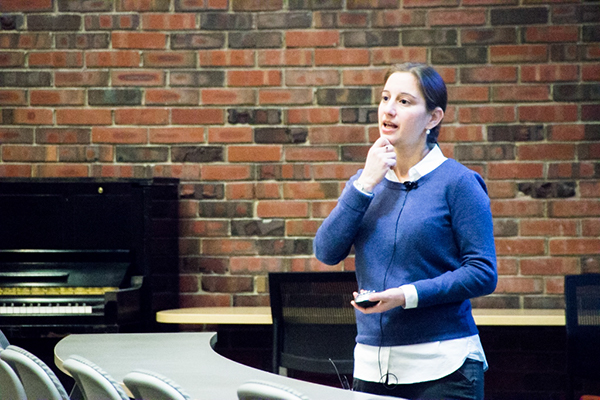
Song is the language of birds. Various frequencies and pitches are akin to human dialects and inflections. Birds sing to fight, flirt and gossip. Kara Belinsky, assistant professor of biology at SUNY New Paltz, is on a mission to become fluent in birdsong.
On Monday Feb. 23, Belinsky hosted an evolutionary studies seminar titled “Songs and the Suburbs: What Birdsong Can Teach Us About Communication And Conservation,” where she discussed her research with the veery (Catharus Fuscescens), a woodland thrush with an unusual and little-studied song. By learning how veerys and other songbirds communicate with each other, she hopes to improve bird habitats and therefore cultivate a better quality of life for all living creatures.
Third-year biology student Rachel Norkelun was drawn to the seminar because she wants to know how humans are “putting weight on or changing the dynamics of the animal.” Belinsky’s upcoming research concerning how birds are affected by urbanization will address this issue.
According to biology lecturer Spencer Mass, Belinsky brought a “much needed enthusiasm for the birds” to SUNY New Paltz when she was hired in 2014. She placed bird feeders around campus last summer in order to study what birds were found on campus at certain times of year. To date, she has recorded the presence of house sparrows, goldfinches, chickadees, mockingbirds, mourning doves, juncos, blue jays and downy woodpeckers.
Matt Richards, a fourth-year environmental biology major, is conducting “a study about the interior and edge of campus forest” in order to learn how mammals are affected by a lack of interior forest. When asked why he attended the seminar, his response was very straightforward: “I love birds.”
Belinsky “can’t imagine not loving birds,” and began research with veerys six years ago while trying to understand what birds were saying to each other. She graduated from Skidmore College in 1998 with a bachelor’s degree in biology and from the University of Massachusetts, Amherst, in 2008 with a Ph.D. in organismic and evolutionary biology.
She conducts her research at the Cary Institute of Ecosystem Studies located in Millbrook, New York, where a large population of veerys can be heard.
“Veerys are basically invisible if they’re not making a sound,” Belinsky said.
She is fascinated by the “shimmering” or ghostly song of the veery, created by the simultaneous use of the lower and upper sections of its voice box. Of all the songbirds, veerys have the largest extent of use of their voice boxes.
The fieldwork aspect of Belinsky’s research is conducted around the dawn chorus’ and dusk chorus’ of songbirds. She and a team will head out to the dense woods where veerys make their home and set up recording equipment to capture the sounds hurling through the air and try to make sense of any recurring patterns.
A standout pattern of veerys is a tendency to sing more at dusk than at dawn. Part of what makes a veery song so unusual is its rapid pitch; this factor also makes the song more difficult to be heard through the large ensemble of birds who sing at dawn.
By creating sonograms, which graph the frequencies and pitch of each individual bird’s song, Belinsky and her team have been able to determine that despite the higher predatory risk of singing at dusk, veerys sing more at that time of day because the “fine details” of their song are more likely to reach the ears of other veerys.
In the upcoming summer months, Belinsky will begin banding birds on campus in order to track their whereabouts on campus and in town. In an attempt to make all of New Paltz more bird-friendly, Belinsky will be reaching out to town residents to ask that they contact her whenever they see one of her banded birds around their home.
Ann Sarrantonio of Rosendale is an avid bird-watcher and was delighted to hear birdsongs in the seminar that she had never encountered before, as well as feeling a deeper connection to the community of New Paltz.
